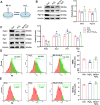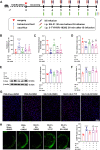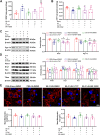SS-31 alleviated nociceptive responses and restored mitochondrial function in a headache mouse model via Sirt3/Pgc-1α positive feedback loop
- PMID: 37271805
- PMCID: PMC10240765
- DOI: 10.1186/s10194-023-01600-6
SS-31 alleviated nociceptive responses and restored mitochondrial function in a headache mouse model via Sirt3/Pgc-1α positive feedback loop
Abstract
Migraine is the second highest cause of disability worldwide, bringing a huge socioeconomic burden. Improving mitochondrial function has promise as an effective treatment strategy for migraine. Szeto-Schiller peptide (SS-31) is a new mitochondria-targeted tetrapeptide molecule that has been shown to suppress the progression of diseases by restoring mitochondrial function, including renal disease, cardiac disease, and neurodegenerative disease. However, whether SS-31 has a therapeutic effect on migraine remains unclear. The aim of this study is to clarify the treatment of SS-31 for headache and its potential mechanisms. Here we used a mouse model induced by repeated dural infusion of inflammatory soup (IS), and examined roles of Sirt3/Pgc-1α positive feedback loop in headache pathogenesis and mitochondrial function. Our results showed that repeated IS infusion impaired mitochondrial function, mitochondrial ultrastructure and mitochondrial homeostasis in the trigeminal nucleus caudalis (TNC). These IS-induced damages in TNC were reversed by SS-31. In addition, IS-induced nociceptive responses were simultaneously alleviated. The effects of SS-31 on mitochondrial function and mitochondrial homeostasis (mainly mitochondrial biogenesis) were attenuated partially by the inhibitor of Sirt3/Pgc-1α. Overexpression of Sirt3/Pgc-1α increased the protein level of each other. These results indicated that SS-31 alleviated nociceptive responses and restored mitochondrial function in an IS-induced headache mouse model via Sirt3/Pgc-1α positive feedback loop. SS-31 has the potential to be an effective drug candidate for headache treatment.
Keywords: Migraine; Mitochondrial dysfunction; Mitochondrial homeostasis; Pgc-1α; SS-31; Sirt3.
© 2023. The Author(s).
Conflict of interest statement
The authors declare no competing interests.
Figures








Similar articles
-
Sirtuin 3, a new target of PGC-1alpha, plays an important role in the suppression of ROS and mitochondrial biogenesis.PLoS One. 2010 Jul 22;5(7):e11707. doi: 10.1371/journal.pone.0011707. PLoS One. 2010. PMID: 20661474 Free PMC article.
-
Mitigation of honokiol on fluoride-induced mitochondrial oxidative stress, mitochondrial dysfunction, and cognitive deficits through activating AMPK/PGC-1α/Sirt3.J Hazard Mater. 2022 Sep 5;437:129381. doi: 10.1016/j.jhazmat.2022.129381. Epub 2022 Jun 16. J Hazard Mater. 2022. PMID: 35752048
-
SIRT3 ameliorates polycystic ovary syndrome through FOXO1/PGC-1α signaling pathway.Endocrine. 2023 Apr;80(1):201-211. doi: 10.1007/s12020-022-03262-x. Epub 2023 Jan 4. Endocrine. 2023. PMID: 36598711
-
Mechanistic insights into AMPK-SIRT3 positive feedback loop-mediated chondrocyte mitochondrial quality control in osteoarthritis pathogenesis.Pharmacol Res. 2021 Apr;166:105497. doi: 10.1016/j.phrs.2021.105497. Epub 2021 Feb 17. Pharmacol Res. 2021. PMID: 33609697 Review.
-
Mitochondrial SIRT3 and neurodegenerative brain disorders.J Chem Neuroanat. 2019 Jan;95:43-53. doi: 10.1016/j.jchemneu.2017.11.009. Epub 2017 Nov 9. J Chem Neuroanat. 2019. PMID: 29129747 Review.
Cited by
-
Circadian Rhythm Cascade SIRT1/PGC-1α/BMAL1 Pathway Regulates Nitroglycerin-Induced Chronic Migraine.Neurochem Res. 2025 Aug 13;50(4):262. doi: 10.1007/s11064-025-04513-9. Neurochem Res. 2025. PMID: 40802209
-
SIRT1-regulated ROS generation activates NMDAR2B phosphorylation to promote central sensitization and allodynia in a male chronic migraine rat model.Front Mol Neurosci. 2024 May 22;17:1387481. doi: 10.3389/fnmol.2024.1387481. eCollection 2024. Front Mol Neurosci. 2024. PMID: 38840778 Free PMC article.
-
Possible Role of Novel Mitochondrial Subsets in Migraine.Life (Basel). 2025 Aug 11;15(8):1273. doi: 10.3390/life15081273. Life (Basel). 2025. PMID: 40868921 Free PMC article. Review.
-
β-cryptoxanthin suppresses oxidative stress via activation of the Nrf2/HO-1 signaling pathway in diabetic kidney disease.Front Pharmacol. 2024 Nov 15;15:1480629. doi: 10.3389/fphar.2024.1480629. eCollection 2024. Front Pharmacol. 2024. PMID: 39619612 Free PMC article.
-
A narrative review of autophagy in migraine.Front Neurosci. 2025 Feb 14;19:1500189. doi: 10.3389/fnins.2025.1500189. eCollection 2025. Front Neurosci. 2025. PMID: 40027467 Free PMC article. Review.
References
-
- Ferrari MD, Goadsby PJ, Burstein R, et al (2022) Migraine. Nature reviews Disease primers 8:2 10.1038/s41572-021-00328-4 - PubMed
MeSH terms
Substances
Grants and funding
LinkOut - more resources
Full Text Sources
Medical
Miscellaneous

